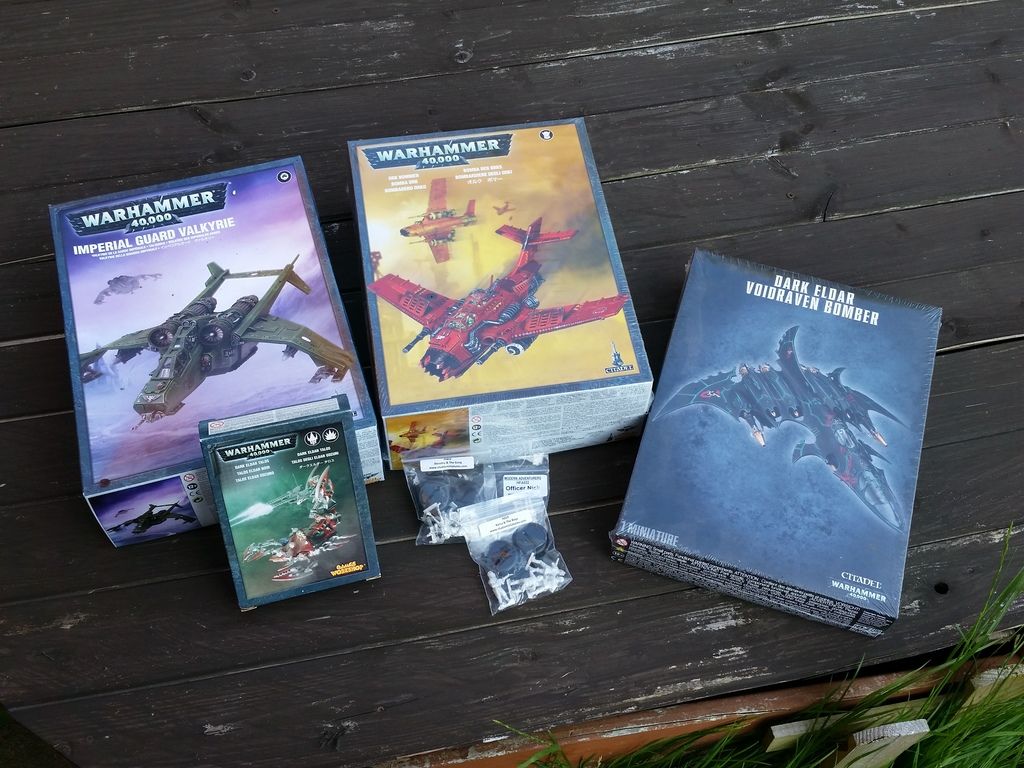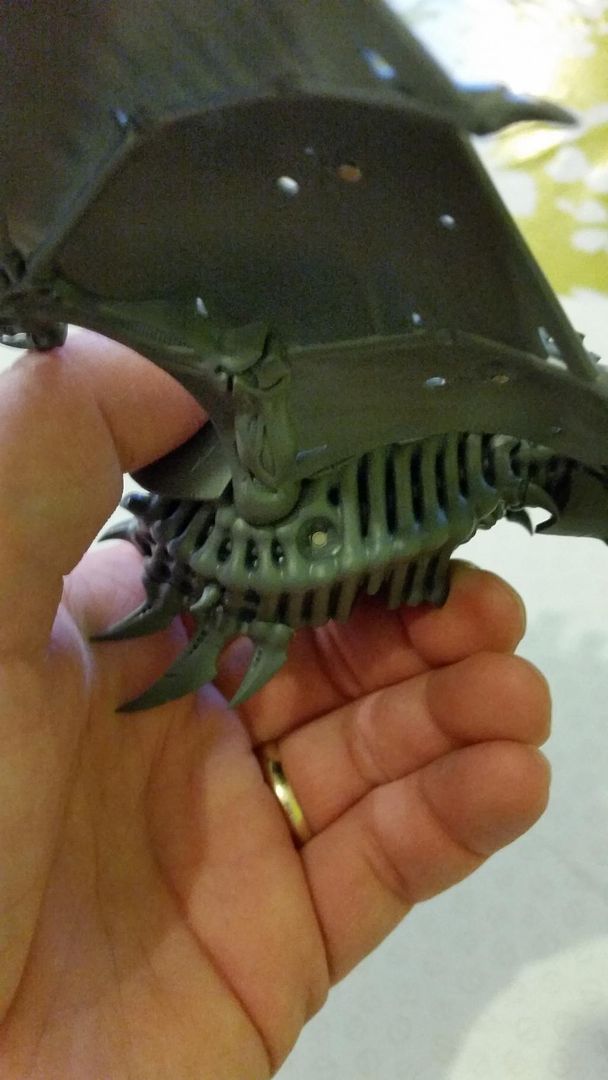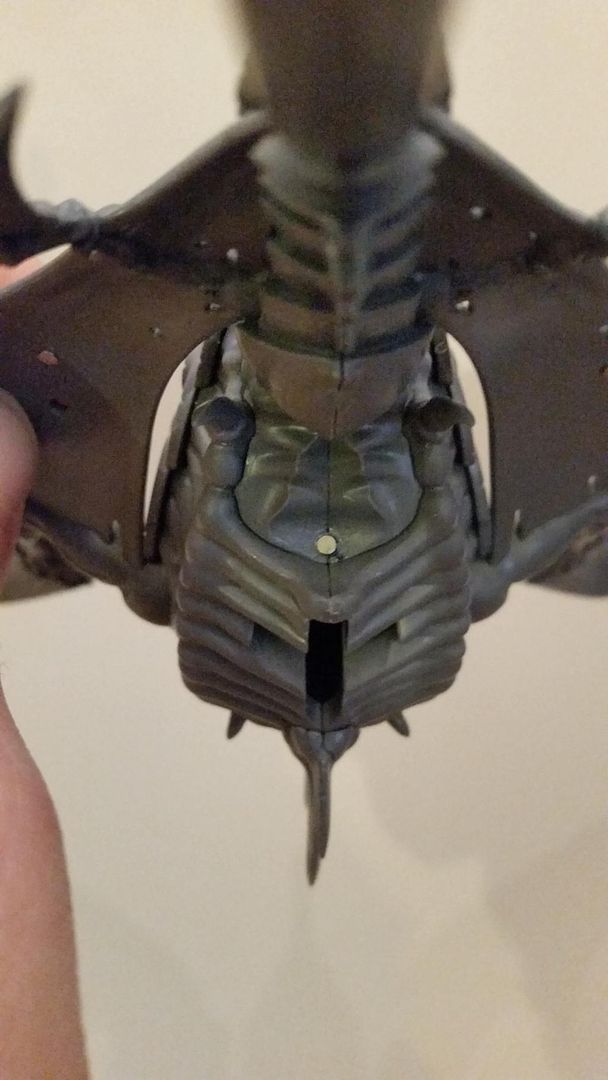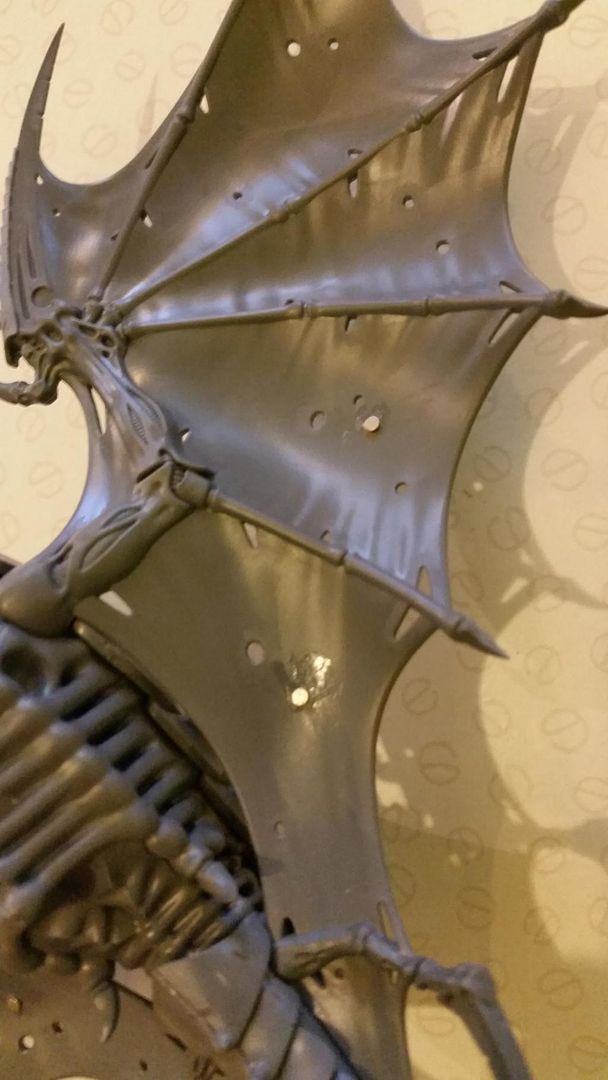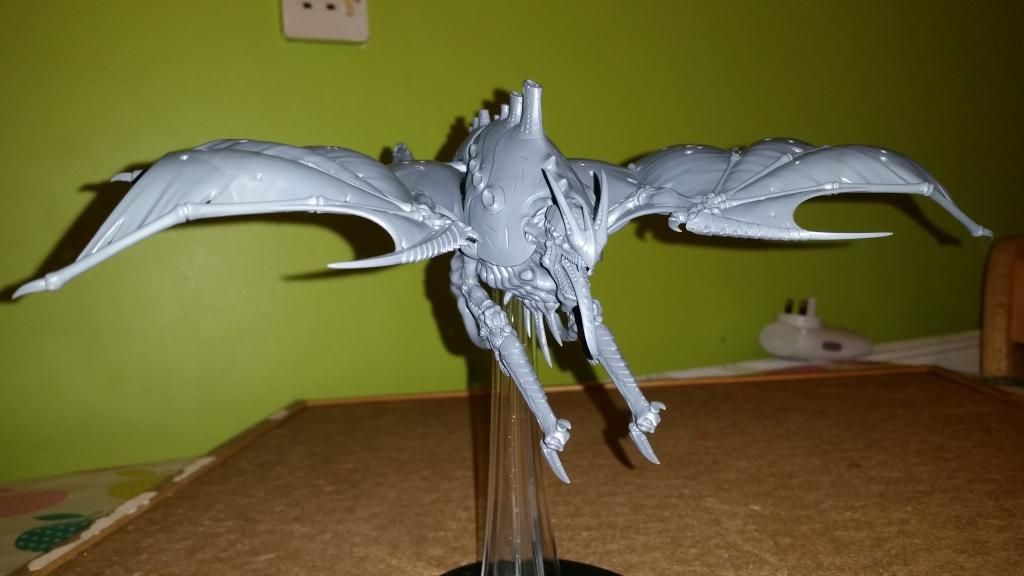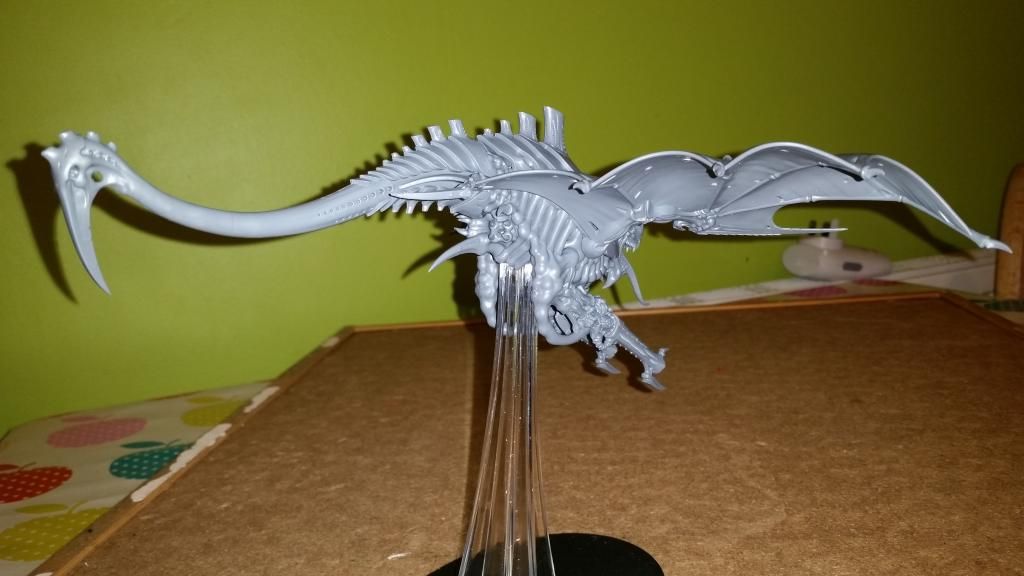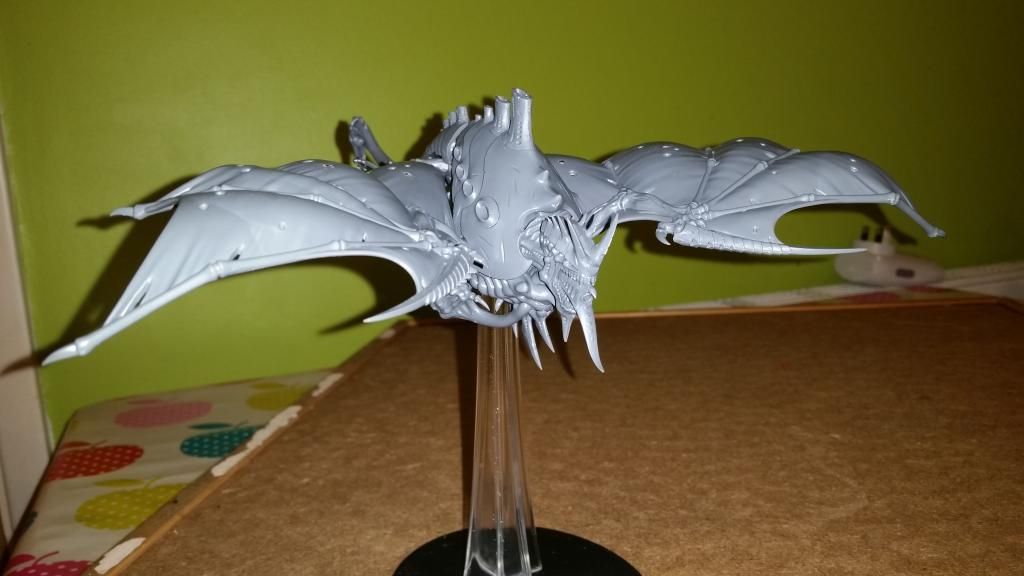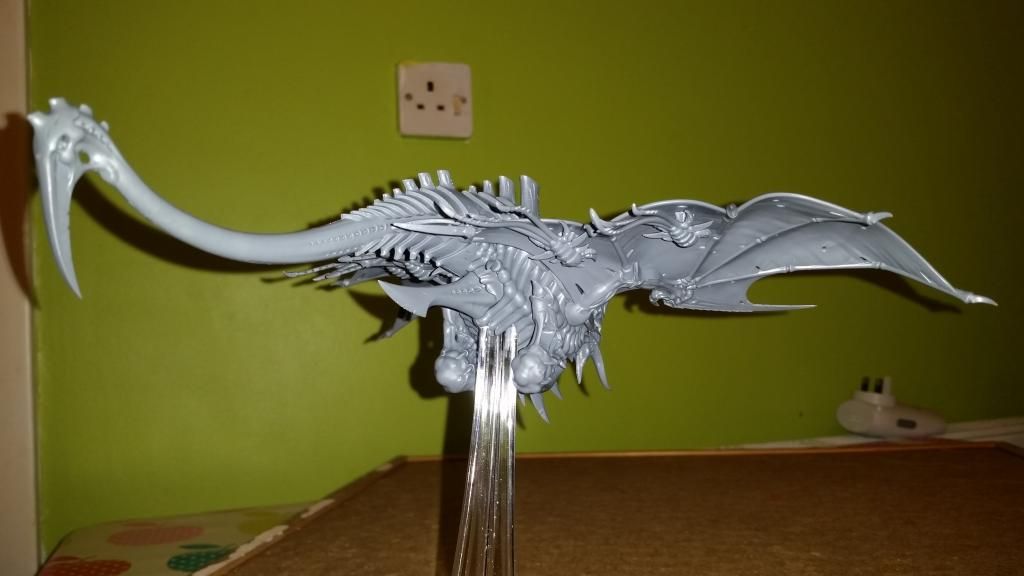Greetings wargamers and hobbyists, welcome to the workbench. This is where I make furniture for the house, carry out minor DIY projects, and dissect bio-monstrosities...
This post is going to be something of a tutorial on how to use magnets to allow you to build a model kit in such a way that you can change pieces over between games to represent any of the kit options, rather than building the model as a single fixed model.
I shall state clearly from the outset that this is intended to be a guide for beginners that will help you get to grips with the tools and methods I use to complete a simple magnetising project, only magnetising the pieces you need to in order to get the kit flexibility you want, not an in depth or advanced tutorial to allow you magnetise every single part to the nth degree. I hope however that once you are comfortable with the concepts presented here, you will have the confidence to try more involved projects.
Also, before I begin, everything I show you here is what I do and the tools I use, having worked things out pretty much for myself. Other people may do things differently, and you should feel free to see what other people have done and cherry pick the best advice available and that suits you. Don't take my word as the only option out there.
So, if we all have our goggles on and brain in gear, I'll begin...
First things first:
CONCEPT
A quick question to start, just to make the mission statement clear: why do we want to magnetise a model kit?
Answer, simply, is to allow us to take bits off the model and exchange them for other bits, so that by the time we're done changing bits, the model either has different weapon options on show, or, like the Harpy/Crone kit, can represent a different unit entirely.
Now you don't have to magnetise a kit to be able to use it as another model, all you really have to do is make it clear to your opponent what the model represents before the game starts and use it as a stand-in. As long as your opponent doesn't have an issue with this, and the proxy isn't wildly inappropriate, this is perfectly fine, but of course if you can change bits over by magnetising the kit instead, why wouldn't you?
Thankfully some kits don't need magnetising to change stuff over. Take the Shadowsword kit for example. I can use the tank as any one of half a dozen variants just by changing out the barrel configuration of the main gun, and this can be done by just push fitting the different bits. The moral of this tale is 'don't make work for yourself'. If you don't need to magnetise something to be able to change it round, don't bother.
Lastly, there is another reason to want to magnetise a kit, and that is ease of storage and transport. Some models might be far easier to pack into a box and cart around, as well as taking up less 'volume' in a storage case if you can disassemble it before packing it away.
Next...
KIT PREPARATION
Before we can get into the meat of how to magnetise a kit, I need to say a word about the work you need to do on the model beforehand. This involves looking at the kit you are assembling, going through the stage by stage assembly guide, and picking out the point at which the basic structure of the model is complete, and the guide splits into two or more sections which explain how to complete the build depending on which option you have elected to construct.
Below are photos of the Harpy/Crone kit assembled to the point where adding anything else takes the kit in one direction or the other. In other words, this is the point you get to where you have completed the assembly of the parts are common to all the options in the kit. The bits you are left with are specific to one build option or another.
Decisions, decisions...
Now I did say that this tutorial is meant to keep things as simple and straight forward as possible, and with that in mind, there may well be bits with some kits that are kind of discretionary when it comes to the need to magnetise them. These tend to be bits that are specific to just one kit option, but don't really affects the overall appearance of the model, and don't form any of the distinct list options, like weapons etc.
Below are some photos of bits I decided to simply choose an option for and glue into place, rather than try and magnetise them. This really was for simplicity's sake. I could have gone all the way and magnetised these bits as well, but that would have taken extra time and also needed a different, additional size of magnet which I would need to purchase for something that doesn't give a huge amount of benefit in the long run. I've seen other tutorials for this kit that did magnetise these bits, and I applaud the dedication of those modellers, but for me, it just wasn't worth the effort.
From left to right, these are: rear talons, tail biomorph, chest bone blades. The reasons I decided to simply choose the bits I liked best and glue them on are as follows:
Rear talons -
The joint on these is just way too small in my opinion to be able to fit magnets at all, they would have to be pinned, which needs wire and alternate drill bits etc. See my rule about not making work for yourself.
Tail biomorph -
This piece could actually be magnetised, but my preferred size of magnet is a little too deep, and the tail may not be able to accommodate it - I would need a shallower magnet. I decided however that it wasn't worth the bother, the expense or the wait to order a pack of smaller magnets just for this piece, so I just glued the tail option I liked into place.
Chest bone blades -
This piece also could be magnetised if I really wanted to, but doing that with the magnets I already had would mean that when the piece wasn't in place, the magnets that hold it in place would be visible, which I wouldn't be happy with. This is because the alternate bits for the other kit option is a series of much smaller spikes, which fit in a different place on the chest. If you look closely you should be able to see that I decided to use both options: the blades, with a couple of the tiny spikes on either side.
So we've made some decisions about bits we are going to glue into place rather than bother to magnetise, and the result is that we have some bits we are not going to use. These are pictured below:
Here we can see the alternative tail piece, the alternative rear talons, the last of the tiny spikes that didn't get used, and the big blade-spikes that go on the top of the carapace. These last bits are the final discretionary assembly decision I made: In order to allow me to magnetise the carapace blades, I would have needed to create greenstuff beds to insert magnets into, which is possible but also time consuming, and as the ability to change these parts over doesn't affect the list options, I decided to take the easy option and glue into place the bits I preferred, pictured below, glued along the flanks of the carapace.

I have done this before on the Nephilim, but those bits were weapon options, and it's not something I would recommend for your first project. I've included photos below so you can see the kind of thing I mean. It's one thing to drill into plastic and glue and magnet in place, and another to have to manufacture a bed to sit the magnets in because there isn't anything but a hole where the pieces go.
TOOLS
so, we've made a few discretionary decisions about what we're going to magnetise and what we aren't, and we've assembled the kit to the point where we're ready to start the magnetising part of the project. Here are the tools I typically use when working on a kit:
Nice and simple. a pin vice, drill bit, green stuff and of course, magnets. It's as as that really. The only other thing you need is super glue, which I assume you will most likely have access to.
Now I have already talked about the use of the green stuff when you need to create a floating bed for a magnet to sit in. I have seen some people use bits if plastic to create elaborate frames that they glue into place to support a magnet, but I thought 'hey, why bother with all the fiddling about. If you aren't going to see it anyway, why not just stuff some putty in the hole?' I like using this method because you can position the magnet while the putty is still soft to make sure you get the depth of the magnets right, which is an important part of the job, and it sticks like concrete when it's set. Like I said though, baby steps.
The most important thing to note about the tools however is this: I use magnets which are the same diameter as the drill bit I use to make the holes the magnets will sit in. On the first project I did, the drill bit I had was a little bigger, so I had to put green stuff in every drill hole to make the magnet sit tight. For the second project I made sure I got myself a drill bit that matched the magnets, and the result was that I could drill the hole, push the magnet in, and in some cases the fit was so snug it didn't even need glue. This makes the whole process much easier and a bit quicker.
As for the magnets themselves, they are
neodymium or
'Rare-earth' magnets, and I buy them on ebay, typically in batches of 100. There are a huge variety of different sizes of these magnets, but the one I have settled on as being both small enough to be useful in magnetising most model components, but strong enough to the job, are cylindrical in shape, 2mm in diameter, and 2mm in depth:
Now before I say another word about these magnets,,,WARNING!
THESE ARE BLOODY POWERFUL MAGNETS,
KEEP THEM THE HELL AWAY FROM ELECTRONIC DEVICES LIKE:
SMART PHONES, COMPUTERS, SMART TV'S, PACEMAKERS ETC.
THEY HAVE THE CAPABILITY TO BUGGER STUFF UP!
That bit is important. So when your packet of magnets arrives in the post, don't stuff it in your pocket alongside your expensive smart phone...
Now the only things you really need to know about the magnets apart from their ability to bring down a Titan by screwing up its main cogitator banks, is that, like most magnets I guess, they have two poles: a negative end, and positive end. This means that two magnets will attract if facing the right way round, and repel each other if one of them is the wrong way round.
The final warning that should come on the packaging of your magnets is that you should not file or try to cut the magnets, and you shouldn't need to do this anyway.
THE BUILD
So, we have our tools and magnets, we've assembled all the common components of the multi-option kit, and we've perhaps made a few decisions about bits we are going to glue into place rather than try and magnetise, for the reasons discussed earlier. We are ready to start installing magnets.
Below are two photos. The bits on the left are the Harpy bits which have had magnets installed, and the bits on the right are for the Hive Crone.

If you look closely, you can see the magnets installed in the various bits - they are the shiny metallic discs. The top pieces in each set of bits are the head and tail. below you can see the arms, and on the Crone photo you can see the Tentaclids. Each piece has a single magnet installed.

The installation of a magnet is as follows: Using your drill bit which is the same diameter as your magnets (in my case a 2mm bit for my 2mm magnets), you position the tip of the bit in the location you want the magnet to sit, and you start off very slowly to make sure the location of the hole doesn't drift. The reason for this is that the magnet in the bits above needs to match the location of the magnet on the main body of the model, otherwise the bits won't sit in the right position, either falling off altogether, or not sitting right because the magnets are misaligned and are pulling the piece to one side and out of place.
It is important that you get this right, but it is just a case of taking your time. Once you have fitted your first few magnets, you'll be more comfortable.
Once you have your hole, it needs to be deep enough to allow the magnet to sit with the surface flush with the surface of the piece. It doesn't matter if you drill the hole too deep (unless that means it pushes right through and out of the other side of the piece, making it look like it took a hit from a Lascannon), because when you push the magnet into the hole, you will only push it until the surface sits flush, not deep into the hole. The idea is to position the magnets on each piece so that when the pieces are in place, the magnets sit in contact with each other and hold the pieces together.
In some cases the hole will be tight enough so that the magnet pushes in snugly and stays put. If the hole is not quite that tight, you will need to prime the hole with a dab of super glue to make sure the magnet stays where it is once it's in the hole. If you don't glue the magnet in when the hole isn't quite tight enough to hold it without, then when you fit the corresponding piece, the magnet in the other bit will pull the magnet back out of its hole, which of course is no good. Getting the holes, and therefore the magnets, in the right place is probably the single most important part of a magnetising project.
Now I'll show you where on the main model I positioned the corresponding magnets.
First, the head. This is where I put the magnet in the neck cavity:
You can clearly see the face of the magnet in the back of the cavity, and it sits flush with the surface of the plastic. Now when you are setting up magnets to make a part interchangeable, like the head for example, and the parts you are fitting the magnets don't give you obvious matching points, then you need to work out how to mark on the heads and the 'neck' where the magnets need to go so they line up correctly.
One way of doing this is to test fit the parts together to work out where you will have nice large contact points between the parts, before deciding where to position the magnets. There is no use in installing magnets in bits that don't meet. I worked on the idea that putting the one 'receiving' magnet in the main body of kit first would make sense, because that is the one that the magents in the two heads would need to match up to. I chose a spot in the back of the neck cavity I thought gave a good contact point, and I drilled a 2mm hole using the 2mm drill bit. Once this was done I added a touch of superglue to the hole, and pushed a magnet in until the top surface of the magnet finished up flush with the surface of the plastic of the neck cavity. If you have used a touch of superglue, then you can keep pushing until the magnet is in position, and when you stop, the glue will hold the magnet fast, so don't stop pushing till the magnet is flush.
Next comes marking where you need to drill the holes in the heads. To make sure that the magnets in the heads would both be positioned to align with the magnet in the neck cavity, I did this by putting a dab of paint on the magnet I had installed in the neck cavity, and then pushed one of the heads into the cavity. This left a spot of paint on the back of the head where it aligned with the magnet in the neck, giving me the spot I needed to drill the hole. I then of course repeated this with the other head.
Earlier I mentioned the poles of the magnets. Now is the time I had to make sure that once I had drilled the holes in the two heads, I installed the magnets the right way round so they would attract to the magnet in the neck, and not repel.
Now these magnets are very fiddly things, and the way I have worked out is the easiest for me to pick up a magnet, make sure it's the right way round, and then get it into its hole is as follows:
- Let one of the magnets stick to the magnet you have already installed - in this case, the neck cavity. This ensures that the magnet is the right way around, and it holds the magnet in place, without needing to try and remove it from its position, which can be tricky while keeping it the right way round.
- Put a dab of superglue in the hole that the magnet is going into - in this case in the back of the head.
- Push the head down into the cavity so that the magnet goes into the hole, and keep pushing until the head is sitting fully into the cavity.
- Wait a minute for the glue to fix the magnet in the hole.
- Pull the head away from the neck cavity.
If everything goes as it should, this should leave the magnet in the neck cavity in its hole, and the newly installed magnet in the back of the head in its hole, with both magnets the right way round and a snug fit of the parts. Now at this stage if you find that the magnet in the back of the head isn't quite flush with the surface of the plastic, either protruding a fraction or pushed in a little, don't worry, because if it's only a fraction and the two pieces were firmly pushed together, it doesn't matter. The main thing it that the magnets are firmly fixed in place, and that the two model parts fit snugly together.
Rinse and repeat with the other head. Once this stage is complete, you should now be able to put either of the two heads in place and it should stay in place, and you should be able to swap them over.
So now we have established the process for installing magnets, using dabs of paint to make sure that all the parts align together, and how to make sure the magnets go in the right way around, you simply repeat the process with the rest of the parts.
The photos below show you where I installed the magnets on the rest of the kit:
First, the 'arm holes':
And the tail:
And the wings - for the Tentaclids:
Now if you look at the photo that shows the Crone pieces earlier, you'll see that after much deliberation I decided to glue the Tentaclids to their 'mounting points' and then magnetise the whole thing to the underside of the wing. I did this for two reasons. First, magnetising the Tentaclids to the mounting points was not practical, and I preferred not to have the mounting points glued on the model when it was set up as the Harpy, because it would look like the Harpy had fired off a load of Tentaclids it didn't have in the first place.
I think it makes little difference to the model to remove the whole Tentaclid and its mounting point when it has been fired in game, because it's fitted under the wing. The main thing is being able to remove the Tentaclid, so that you can remove them as they are fired, and take them all off when switching to 'Harpy mode'. As luck would have it, the little holes in the back of the Tentaclid mounting points are exactly 2mm in diameter, so it was no brainer really as they came pre-drilled!
Here are the photos of the kit set up as the two options once all the magnets were in place. First, the Harpy:
And now the Crone:
Just a couple of hints below:
- Dry fit pieces before super gluing either pieces or magnets in place - it's not an easy thing to get a superglued magnet out a hole.
- Avoid pushing a magnet through the hole you have drilled in a piece that has a closed cavity, like the head. Once inside, you won't get it out without cutting your model apart (so it pays to have plenty of magnets), and your model will make a nice rattling sound as it flies around the table.
- One for the Harpy/Crone kit specifically - glue the tongue in place BEFORE you glue the two sides of the head together - it won't fit past the teeth afterwards!
I hope that this article is of use. Please feel free to ask questions or suggest any points I haven't covered which might be good to add in. I haven't gone through the fitting of every piece individually, because the principles are the same pretty much every time, and I hope the photos of all the pieces and their magnet positions will be enough, plus, the article would be three times longer.
Take your time with your first attempt. Once you have successfully installed your first couple and your brain has accepted the programming, it becomes much easier.
Good luck, and thanks for reading...
P.S. As of this morning, my painting total for this year stands at 66 painted infantry models out of a target of 40!


